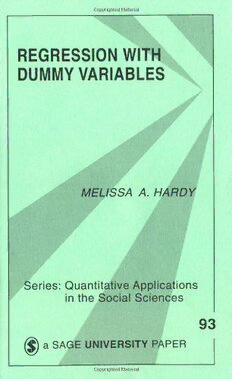Download Regression with Dummy Variables (Quantitative Applications in the Social Sciences) issue 93 PDF Free - Full Version
Download Regression with Dummy Variables (Quantitative Applications in the Social Sciences) issue 93 by Professor Melissa A Hardy in PDF format completely FREE. No registration required, no payment needed. Get instant access to this valuable resource on PDFdrive.to!
About Regression with Dummy Variables (Quantitative Applications in the Social Sciences) issue 93
It is often necessary for social scientists to study differences in groups, such as gender or race differences in attitudes, buying behavior, or socioeconomic characteristics. When the researcher seeks to estimate group differences through the use of independent variables that are qualitative, dummy variables allow the researcher to represent information about group membership in quantitative terms without imposing unrealistic measurement assumptions on the categorical variables. Beginning with the simplest model, Hardy probes the use of dummy variable regression in increasingly complex specifications, exploring issues such as: interaction, heteroscedasticity, multiple comparisons and significance testing, the use of effects or contrast coding, testing for curvilinearity, and estimating a piecewise linear regression.
Detailed Information
| Author: | Professor Melissa A Hardy |
|---|---|
| Publication Year: | 1993 |
| ISBN: | 9780803951280 |
| Pages: | 100 |
| Language: | English |
| File Size: | 4.909 |
| Format: | |
| Price: | FREE |
Safe & Secure Download - No registration required
Why Choose PDFdrive for Your Free Regression with Dummy Variables (Quantitative Applications in the Social Sciences) issue 93 Download?
- 100% Free: No hidden fees or subscriptions required for one book every day.
- No Registration: Immediate access is available without creating accounts for one book every day.
- Safe and Secure: Clean downloads without malware or viruses
- Multiple Formats: PDF, MOBI, Mpub,... optimized for all devices
- Educational Resource: Supporting knowledge sharing and learning
Frequently Asked Questions
Is it really free to download Regression with Dummy Variables (Quantitative Applications in the Social Sciences) issue 93 PDF?
Yes, on https://PDFdrive.to you can download Regression with Dummy Variables (Quantitative Applications in the Social Sciences) issue 93 by Professor Melissa A Hardy completely free. We don't require any payment, subscription, or registration to access this PDF file. For 3 books every day.
How can I read Regression with Dummy Variables (Quantitative Applications in the Social Sciences) issue 93 on my mobile device?
After downloading Regression with Dummy Variables (Quantitative Applications in the Social Sciences) issue 93 PDF, you can open it with any PDF reader app on your phone or tablet. We recommend using Adobe Acrobat Reader, Apple Books, or Google Play Books for the best reading experience.
Is this the full version of Regression with Dummy Variables (Quantitative Applications in the Social Sciences) issue 93?
Yes, this is the complete PDF version of Regression with Dummy Variables (Quantitative Applications in the Social Sciences) issue 93 by Professor Melissa A Hardy. You will be able to read the entire content as in the printed version without missing any pages.
Is it legal to download Regression with Dummy Variables (Quantitative Applications in the Social Sciences) issue 93 PDF for free?
https://PDFdrive.to provides links to free educational resources available online. We do not store any files on our servers. Please be aware of copyright laws in your country before downloading.
The materials shared are intended for research, educational, and personal use in accordance with fair use principles.

